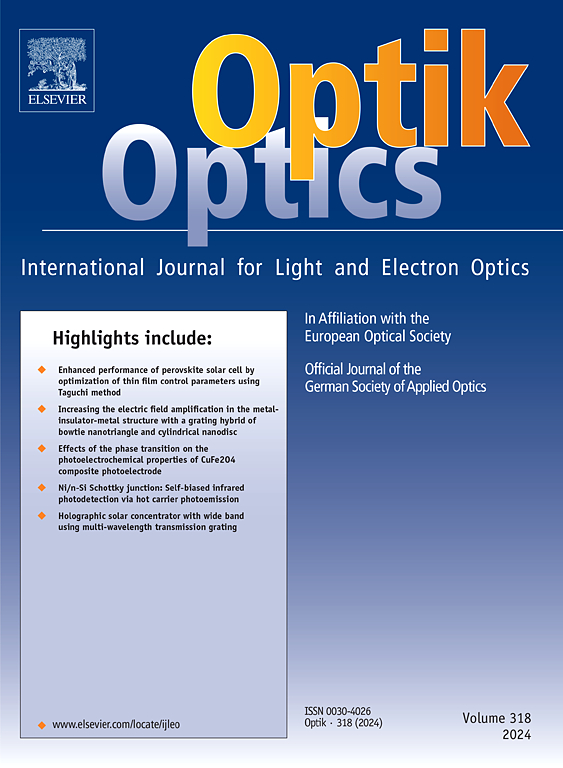利用酞菁锡吸收体调q锁模光纤激光器的实验研究
IF 3.1
3区 物理与天体物理
Q2 Engineering
引用次数: 0
摘要
我们提出了一种利用酞菁锡(SnPc)作为可饱和吸收剂(SA)的调q锁模掺铒光纤激光器(EDFL)的实验研究。SnPc溶液沉积在光纤插套连接器的端面上,显示出19.4 %的显著调制深度。该无源SA器件被集成到EDFL腔中,产生中心波长为1561.8 nm的调q脉冲。泵浦功率范围为12.13 ~ 67.52 mW,重复频率和脉冲宽度范围为21.85 kHz / 12.16µs ~ 58.34 kHz / 6.32µs。该调q激光器效率高达9.16 %,峰值输出功率为5.9 mW。信噪比(SNR)为57.02 dB,表明q开关工作稳定。将EDFL腔体扩展到162 m后,可获得5.05 ps的稳定锁模脉冲,泵浦功率超过85.99 mW。当泵浦功率为210.62 mW时,锁模输出的重复频率为1.28 MHz,最大脉冲能量为1.63 nJ,峰值功率为0.28 kW。频谱显示了66.70 dB的高信噪比,验证了稳定的锁模性能。工作频率为1559.8 nm,这种皮秒脉冲序列在频率梳生成、高精度光学计量和宽带吸收光谱等应用中具有巨大的潜力。这些结果突出了SnPc有机材料作为未来光子应用的高效饱和吸收剂的前景。本文章由计算机程序翻译,如有差异,请以英文原文为准。
Experimental investigation of Q-switched and mode-locked fiber lasers using tin phthalocyanine absorber
We present an experimental investigation of a Q-switched and mode-locked erbium-doped fiber laser (EDFL) utilizing tin phthalocyanine (SnPc) as a saturable absorber (SA). The SnPc solution, deposited on the end face of a fiber ferrule connector, exhibits a notable modulation depth of 19.4 %. This passive SA device was incorporated into the EDFL cavity to generate Q-switched pulses at a center wavelength of 1561.8 nm. With pump powers ranging from 12.13 to 67.52 mW, the repetition rate and pulse width varied from 21.85 kHz / 12.16 µs to 58.34 kHz / 6.32 µs. The Q-switched laser demonstrated an efficiency of up to 9.16 %, with a peak output power of 5.9 mW. A signal-to-noise ratio (SNR) of 57.02 dB confirmed stable Q-switching operation. Upon extending the EDFL cavity to 162 m, stable mode-locked pulses of 5.05 ps were achieved with pump powers exceeding 85.99 mW. At 210.62 mW pump power, the mode-locked output exhibited a repetition rate of 1.28 MHz, a maximum pulse energy of 1.63 nJ, and a peak power of 0.28 kW. The frequency spectrum demonstrated a high SNR of 66.70 dB, verifying stable mode-locking performance. Operating at 1559.8 nm, this picosecond pulse train holds significant potential for applications such as frequency comb generation, high-precision optical metrology, and broadband absorption spectroscopy. These results highlight the promise of SnPc organic materials as efficient saturable absorbers for future photonic applications.
求助全文
通过发布文献求助,成功后即可免费获取论文全文。
去求助
来源期刊

Optik
物理-光学
CiteScore
6.90
自引率
12.90%
发文量
1471
审稿时长
46 days
期刊介绍:
Optik publishes articles on all subjects related to light and electron optics and offers a survey on the state of research and technical development within the following fields:
Optics:
-Optics design, geometrical and beam optics, wave optics-
Optical and micro-optical components, diffractive optics, devices and systems-
Photoelectric and optoelectronic devices-
Optical properties of materials, nonlinear optics, wave propagation and transmission in homogeneous and inhomogeneous materials-
Information optics, image formation and processing, holographic techniques, microscopes and spectrometer techniques, and image analysis-
Optical testing and measuring techniques-
Optical communication and computing-
Physiological optics-
As well as other related topics.
 求助内容:
求助内容: 应助结果提醒方式:
应助结果提醒方式:


